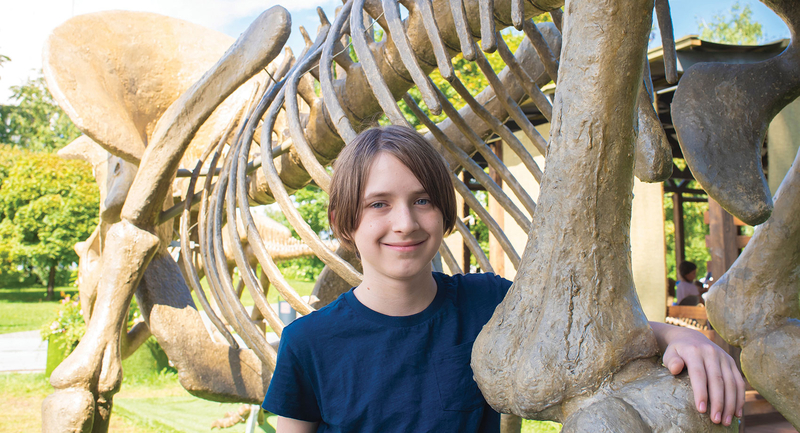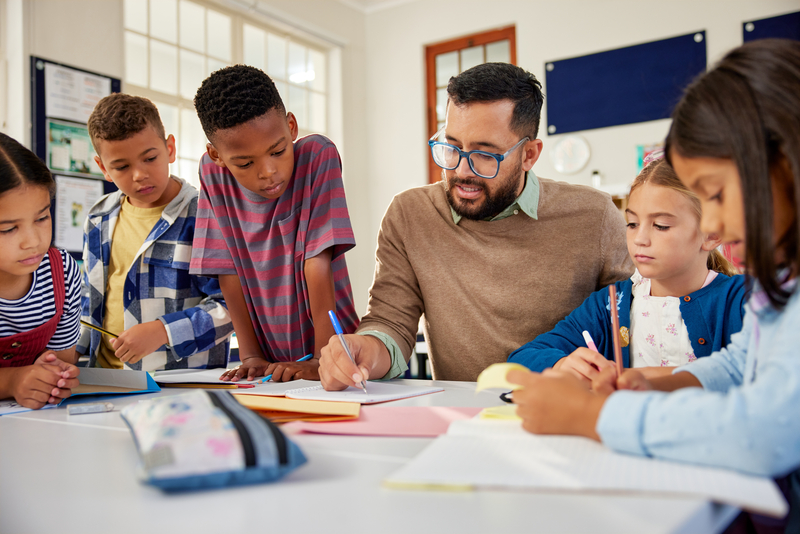After one of my discussion classes, a 7th grader asked, "What is the point of a discussion class? We don't have to memorize anything. We don't take tests. We just sit around and talk." Before I could answer, another student, a young Russian émigré, replied, "What is the point? Only that discussion teaches you how to live!"
And it does. People trapped in the Warsaw ghetto during World War II met together to discuss the few books remaining to them. Conversation keeps us human when all else is stripped away. In more secure times, exchanging ideas with others can elicit our empathetic imagination. Teaching students to listen to others and express their own ideas gives them the resilience and resourcefulness to handle whatever the future holds.
The ideas that students articulated in our discussion of Robert Frost's poem "Fire and Ice" were quite different from mine. I have always understood the poem, in which the poet muses about how the world will end, as a commentary on the Cold War. But many of my middle school students, who were born well after the fall of the Berlin Wall and who have grown up with the green movement, interpreted it as an ecological warning.
Students also pondered Descartes' comment in his Discourse on Method— that common sense is fairly distributed among people because everyone believes he has enough of it. A number of students somewhat sheepishly admitted that they thought they had more common sense than others they knew. (Who would admit to having less?)
And when we read from The Confessions, a number of students agreed with St. Augustine that he was right to worry that the pleasure he found in music could subvert his reason and undermine his relationship with God. "Sometimes music can overshadow what the lyrics are saying. Then you can't hear clearly," one student said. We talked about Augustine's definition of reason—not "cause" but "thinking clearly."
Today, thoughtful, reflective readings and discussions like these appear to be on the decline. They are now in a Sisyphean battle against the unmediated forces of Twittering, Facebooking, and YouTubing. As society transitions from the physicality of print to the endless horizon of digital dissemination, educators have an obligation to sustain balancing elements in students' lives. Conversations about great texts can yield important compass bearings, pointing students toward deeper reflection and greater humanity.
Cultivating Wonder
How can teachers build sophisticated thinking—such as inference, critical analysis, and insight—while introducing the younger generation to the legacy of ideas that illuminate our understanding of the world? How can we enable students to take control of their learning? How can we lead them to see that true learning is not about satisfying the test maker but about satisfying their own wondering?
An answer lies in giving students a forum for conversation. One program I've found valuable is the Touchstones Discussion Project (see www.touchstones.org). As librarian and Touchstones discussion leader at St. Martin's-in-the-Field Day School, I have used this program in our middle school library curriculum for the past five years. St Martin's is a coeducational Episcopal K–8 school in Maryland serving some 350 students.
The Touchstones Discussion Project was founded by professors at St. John's College in Annapolis, Maryland, whose Great Books–based program grew out of an education approach pioneered at the University of Chicago. The discussions incorporate principles of dialogue for use at any grade level: communal reading of a text, exploration of ideas on the basis of inquiry, active listening, respect for differing points of view, facility in expressing ideas, and openness to change.
Touchstones discussions focus on photographs, paintings, and brief written selections that take 3–5 minutes to read aloud. These are included in reading booklets for each grade. My middle school students have read such authors as Aristotle, Euclid, Francis Bacon, St. Thomas Aquinas, Buddha, Thomas Jefferson, Isaac Newton, Immanuel Kant, Mary Shelley, and Richard Feynman. Students have also read and discussed folktales from Chinese, Persian, Nigerian, Japanese, and American Indian cultures. We've discussed such artists as Vermeer and Bruegel the Elder. I encourage the use of primary texts, not textbook copy—it's the difference between fresh and canned peas.
Students do not read the selection in advance or prepare in any way. Rather, they encounter a reading or an image in our meeting and apply reasoned thought and inquiry to the topic. Over four years, our 5th through 8th graders meet once a week in the school library. We sit in a circle—the seating arrangement most conducive to exchanging views. The teacher or discussion leader is a member of the group, neither elevated nor isolated.
In our discussions, we complete the circle that Socrates dreaded would be broken with the rise of the written word. Living at the junction between a culture of orality and a culture of literacy, Socrates argued in Plato's Phaedrus that the young would lose initiative and continuity in their thinking without the immediacy of an elder's guidance, which is readily available in conversational exchange. (It is ironic that Socrates' pupil, Plato, recorded his teacher's objections in writing.)
Today we stand at another pivotal moment in reading's evolution, as ink on paper may go the way of the bard in the firelight or the philosopher in the grove. Yet there is one constant. In classrooms, families, the workplace, politics, and the courtroom, conversations between people open new pathways. The skills we associate with discussion— reading carefully, listening closely, speaking cogently, and maintaining civility—shape us as self-aware, self-governing, self-inspiring, and self-supporting adults. The skills that students develop in discussion will be with them all their lives.
But we also converse because it's pleasurable. It's exciting to exchange ideas, understand another's viewpoint, or persuade someone to see things differently. In discussion, we are not simply consumers or decoders of information. We connect. In reading a text in common, we find common ground.
Discussion Guidelines
There are only four guidelines for a Touchstones discussion, which are replicable in any discussion: (1) Read the text carefully, (2) listen to others and do not interrupt, (3) speak clearly, and (4) respect others. (When I do this program with adults in prison, the ground rules also include (5) keep it real and (6) no profanity.)
I start by reading the essay aloud and ask my students to follow along. I have found that the teacher should always read first, because she or he is best able to impart meaning in that first reading. I read with attention to punctuation and with appropriate expression. I ask students to volunteer to read aloud for a second or third reading. Many shy students love reading to the class; it's an opportunity for quiet students to hear their own voices.
I encourage students to ask about unfamiliar vocabulary because understanding the meaning of a word is crucial to grasping the meaning of the whole. Words that have flummoxed my students include carfare from Langston Hughes's great poem on friendship and poverty, "Buddy"; deferential and vehementin Elizabeth Cady Stanton's speech to the National American Woman Suffrage Association in 1890; andimpetuous from Plato's Symposium. We had some humorous crosstalk when we read from The Seven Books by Mencius because an 8th grader misunderstoodprofit as prophet.
After our communal reading, students reflect in writing on the selection. For example, when 5th graders read the fable "The Tortoise and the Rabbit" by Aesop and the folktale "The Tortoise and the Antelope" from the Ngoni people from east-central Africa, they write a story about a race between a fast and slow animal. They have to come up with an idea for making the slow animal win. This class often ends with newly minted fables about sloths, hermit crabs, dogs lazing in the sun— and, once, a flat-footed penguin who learned to sled.
Students then shift to small groups, each of which chooses a chairperson who organizes the discussion and keeps the group focused. Shy students may find it easier to talk in these small groups. The class then reassembles in the full circle for discussion.
Students discover two important insights about reading and discussion: (1) If they don't attend to the reading, they won't be able to offer worthwhile, coherent opinions; and (2) in the course of shared, open discussion, they will come to understand something in a text that was initially confusing or opaque. Similarly, they may find that a text that appeared simple on first reading is more layered and nuanced than they thought. Franz Kafka is good for that.
One distinctive feature of Touchstones discussions is that there is no hand raising. This is a hard adjustment for students (and teachers) to make. It can be comical during the first few discussions as hands fly up, then just as quickly shoot down as students remind one another, "Don't raise your hand. Just speak." Students learn to find their entrance in a group discussion and recognize the subtle signals of someone who wants to join in. Civility plays a role here, as students learn to make room for those who want to speak.
A Touchstones discussion differs from a Socratic-style dialogue in that the teacher does not angle for a certain interpretation. I facilitate the conversation, but I'm not an authority on the text. I tell students that they have as much right to question and explore the text as I do. Casting back the mantle of responsibility to them as readers is a fundamental change in the relationship between students and the texts they read.
Into the Heart of the Discussion
Recently, my 8th grade class discussed a passage from Aristotle's Physics, in which Aristotle identifies the meanings of the word cause. I started by reading the passage aloud. One boy noted that he liked the idea of cause being the shape or pattern of something. If you looked at the night sky, he said, it was interesting to try to discern a pattern or reason. Another student said the definition that most interested her was cause as something that is responsible for something else. "I like the idea of origin," she said. "It seems that the cause of something is the way it begins. I agree with Aristotle that the parents 'cause' the baby." There were some snickers to this.
"I'm not sure I agree with you," said a student politely. "Cause seems more related to outcome, what something is good for. When Aristotle says the cause of geese flying south for the winter is that it is good for them to be in a warm place, then that seems to be the main cause of their going south."
I then asked the students to think about what the "cause" of our Touchstones classes was. To read and have ideas? That would be cause as origin. To become good thinkers and speakers? That would be cause as outcome.
"We've discussed so many different causes," said a student. "This is Aristotle— a big name. Do we have a right to question him?"
A student replied,
We can question him. How else would we understand what he's saying? I also don't agree with him. He's trying to set up a hierarchy of cause and say that one cause—the outcome—is the most important. I don't think you can say "most important" because what's important depends on what matters to you at the time.
As students got up to leave at the end of the class, shouldering their backpacks, one said, "I never thought of so many causes before. I never really stopped to think about what's behind it."
All Disciplines—and Parents—Welcomed
Touchstones discussions encompass an interdisciplinary array of readings drawn from folktales, literature, law, philosophy, history, social sciences, science, art, and mathematics. Is it possible to have a lively discussion of a Euclidean proof? Absolutely.
In a recent class, my students expressed surprise that some expository writing focused on mathematics. A passage from A Mathematician's Apology, by G. H. Hardy, proposes that mathematics can be beautiful. After a fair amount of grumbling that math was serious but not beautiful, one student said, "Well, because time exists outside our individual life spans, I suppose you could say that mathematics, in that sense, is beautiful and gives us measurement and meaning beyond our lives." At that moment, the change in my 8th graders' perception of mathematics was palpable.
In conjunction with units on colonial America, we might read from the writings of Thomas Jefferson or Alexis de Tocqueville or from the Federalist Papers. After reading the U.S. Bill of Rights, one student summed up the feelings of our group when she said, referring to the First Amendment, "I'm amazed that our American way of life comes from these four or five lines of text."
Touchstones discussions also provide an opportunity to invite parents to participate and to include guests from other schools and local colleges. We had a parent participant for a 5th grade reading on the "Life of Lycurgus" from Plutarch's Lives. Lycurgus, the lawgiver of Sparta, forbade travel abroad or visits from strangers. The students noted that, unlike ancient Sparta, we welcomed visitors.
The Payoff?
We recognize successful adults as those who are most adroit in knowing when to speak, when to interject, how to build on others' ideas, and how to make a point through humor and style. The person who listens, analyzes what's going on, and presents a synthesis that enables the group to reach another level of thinking—this individual will be the one whom others look to.
Does weekly practice in intellectual discourse help create such learners? What happens to my students after our Touchstones discussions?
High school admission directors and teachers have told me that our St. Martin's-in-the-Field middle school graduates are known for being articulate, at ease in classroom discussion, and civil. A college professor attended a 7th grade two-hour final exam based on a discussion about the roles of religion in society. The students had studied this topic in a social studies unit on Christianity, Islam, Judaism, and Buddhism. He came out of the room shaking his head, saying, "That seminar was as good as any in my college—and better than many."
Learning the dynamics of discussion has helped many students. One alumna, who rarely spoke during Touchstones discussions, told me that as a result of her participation in the program, she had gradually overcome her fear of speaking. She had become comfortable with uncertainty and disagreement and had grown to value every contribution—her own included.
The transformational moment—the magic—happens when students apply the Touchstones discussion approach to their own interests. After we read On Nature, in which the author Lucretius imagines a man throwing a spear at the edge of the universe, a 6th grader brought in a DVD showing a view of space from the Hubble telescope.
Such discussions teach students not only to have confidence in their own interests but also to become lifelong learners. Reading closely, posing questions, probing an idea—these are the spearheads of curiosity that carry us to the edge of our known worlds, and then a step beyond.








